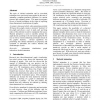Free Online Productivity Tools
i2Speak
i2Symbol
i2OCR
iTex2Img
iWeb2Print
iWeb2Shot
i2Type
iPdf2Split
iPdf2Merge
i2Bopomofo
i2Arabic
i2Style
i2Image
i2PDF
iLatex2Rtf
Sci2ools
APVIS
2004
2004
Skeletal Animation for the Exploration of Graphs
The topic of skeletal animation and its associated techniques have previously been applied in the area of animating computer-generated characters for motion pictures and computer games. This paper investigates the use of similar techniques in the scope of exploring three-dimensional visualisations of graphs. A system is discussed which, after generating an initial 3D layout for a graph, creates a structural "skeleton" of the graph and allows a user to push, pull and drag nodes of the skeleton in order to manipulate the layout. Skeletal animation is used to smoothly animate the graph layout according to the movement applied by the user as well as various underlying constraints forced on the graph's skeleton. Several algorithms for performing this skeletal animation are proposed, and evaluated to determine the relative benefits and disadvantages of each.
| Added | 30 Oct 2010 |
| Updated | 30 Oct 2010 |
| Type | Conference |
| Year | 2004 |
| Where | APVIS |
| Authors | Damian Merrick, Tim Dwyer |
Comments (0)

